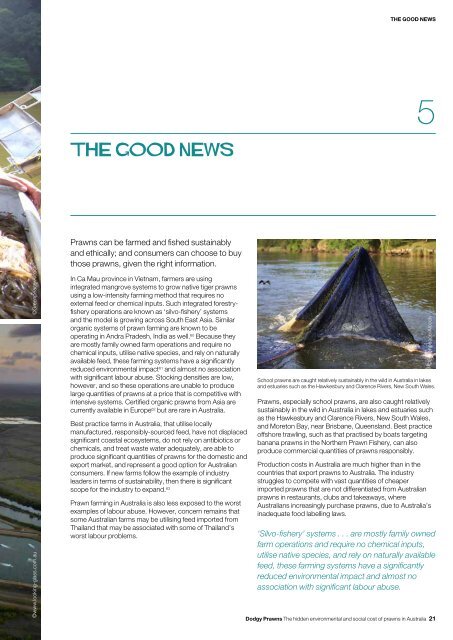Prawns
UREzh60p
UREzh60p
You also want an ePaper? Increase the reach of your titles
YUMPU automatically turns print PDFs into web optimized ePapers that Google loves.
THE GOOD NEWS<br />
5<br />
The good news<br />
©Greenpeace/Alcock<br />
©www.looking-glass.com.au<br />
<strong>Prawns</strong> can be farmed and fished sustainably<br />
and ethically; and consumers can choose to buy<br />
those prawns, given the right information.<br />
In Ca Mau province in Vietnam, farmers are using<br />
integrated mangrove systems to grow native tiger prawns<br />
using a low-intensity farming method that requires no<br />
external feed or chemical inputs. Such integrated forestryfishery<br />
operations are known as ‘silvo-fishery’ systems<br />
and the model is growing across South East Asia. Similar<br />
organic systems of prawn farming are known to be<br />
operating in Andra Pradesh, India as well. 60 Because they<br />
are mostly family owned farm operations and require no<br />
chemical inputs, utilise native species, and rely on naturally<br />
available feed, these farming systems have a significantly<br />
reduced environmental impact 61 and almost no association<br />
with significant labour abuse. Stocking densities are low,<br />
however, and so these operations are unable to produce<br />
large quantities of prawns at a price that is competitive with<br />
intensive systems. Certified organic prawns from Asia are<br />
currently available in Europe 62 but are rare in Australia.<br />
Best practice farms in Australia, that utilise locally<br />
manufactured, responsibly-sourced feed, have not displaced<br />
significant coastal ecosystems, do not rely on antibiotics or<br />
chemicals, and treat waste water adequately, are able to<br />
produce significant quantities of prawns for the domestic and<br />
export market, and represent a good option for Australian<br />
consumers. If new farms follow the example of industry<br />
leaders in terms of sustainability, then there is significant<br />
scope for the industry to expand. 63<br />
Prawn farming in Australia is also less exposed to the worst<br />
examples of labour abuse. However, concern remains that<br />
some Australian farms may be utilising feed imported from<br />
Thailand that may be associated with some of Thailand’s<br />
worst labour problems.<br />
School prawns are caught relatively sustainably in the wild in Australia in lakes<br />
and estuaries such as the Hawkesbury and Clarence Rivers, New South Wales.<br />
<strong>Prawns</strong>, especially school prawns, are also caught relatively<br />
sustainably in the wild in Australia in lakes and estuaries such<br />
as the Hawkesbury and Clarence Rivers, New South Wales,<br />
and Moreton Bay, near Brisbane, Queensland. Best practice<br />
offshore trawling, such as that practised by boats targeting<br />
banana prawns in the Northern Prawn Fishery, can also<br />
produce commercial quantities of prawns responsibly.<br />
Production costs in Australia are much higher than in the<br />
countries that export prawns to Australia. The industry<br />
struggles to compete with vast quantities of cheaper<br />
imported prawns that are not differentiated from Australian<br />
prawns in restaurants, clubs and takeaways, where<br />
Australians increasingly purchase prawns, due to Australia’s<br />
inadequate food labelling laws.<br />
‘Silvo-fishery’ systems . . . are mostly family owned<br />
farm operations and require no chemical inputs,<br />
utilise native species, and rely on naturally available<br />
feed, these farming systems have a significantly<br />
reduced environmental impact and almost no<br />
association with significant labour abuse.<br />
Dodgy <strong>Prawns</strong> The hidden environmental and social cost of prawns in Australia 21<br />
©Greenpeace/Alcock


